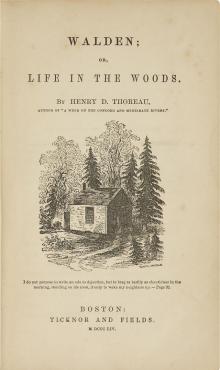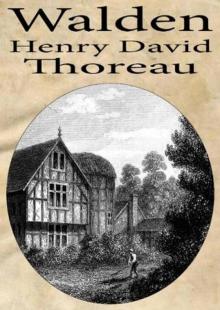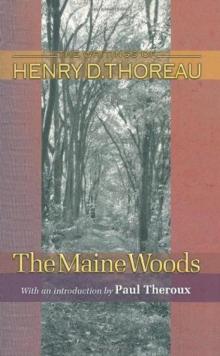- Home
- Henry David Thoreau
The Essays of Henry D. Thoreau Page 8
The Essays of Henry D. Thoreau Read online
Page 8
Where, on some friendly Ararat,
Resteth the weary water-rat.
No ripple shows Musketaquid,
Her very current e’en is bid,
As deepest souls do calmest rest
When thoughts are swelling in the breast,
And she that in the summer’s drought
Doth make a rippling and a rout,
Sleeps from Nahshawtuck to the Cliff,
Unruffled by a single skiff.
But by a thousand distant hills
The louder roar a thousand rills,
And many a spring which now is dumb,
And many a stream with smothered hum,
Doth swifter well and faster glide,
Though buried deep beneath the tide.
Our village shows a rural Venice,
Its broud lagoons where yonder fen is;
As lovely as the Bay of Naples
Yon placid cove amid the maples;
And in my neighbor’s field of corn
I recognize the Golden Horn.
Here Nature taught from year to year,
When only red men came to hear,—
Methinks’t was in this school of art
Venice and Naples learned their part;
But still their mistress, to my mind,
Her young disciples leaves behind.
The fisherman now repairs and launches his boat. The best time for spearing is at this season, before the weeds have begun to grow, and while the fishes lie in the shallow water, for in summer they prefer the cool depths, and in the autumn they are still more or less concealed by the grass. The first requisite is fuel for your crate; and for this purpose the roots of the pitch pine are commonly used, found under decayed stumps, where the trees have been felled eight or ten years.
With a crate, or jack, made of iron hoops, to contain your fire, and attached to the bow of your boat about three feet from the water, a fish-spear with seven tines and fourteen feet long, a large basket or barrow to carry your fuel and bring back your fish, and a thick outer garment, you are equipped for a cruise. It should be a warm and still evening; and then, with a fire crackling merrily at the prow, you may launch forth like a cucullo into the night. The dullest soul cannot go upon such an expedition without some of the spirit of adventure; as if he had stolen the boat of Charon and gone down the Styx on a midnight expedition into the realms of Pluto. And much speculation does this wandering star afford to the musing night-walker, leading him on and on, jack-o’-lantern-like, over the meadows; or, if he is wiser, he amuses himself with imagining what of human life, far in the silent night, is flitting moth-like round its candle. The silent navigator shoves his craft gently over the water, with a smothered pride and sense of benefaction, as if he were the phosphor, or light-bringer, to these dusky realms, or some sister moon, blessing the spaces with her light. The waters, for a rod or two on either hand and several feet in depth, are lit up with more than noonday distinctness, and he enjoys the opportunity which so many have desired, for the roofs of a city are indeed raised, and he surveys the midnight economy of the fishes. There they lie in every variety of posture; some on their backs, with their white bellies uppermost, some suspended in mid-water, some sculling gently along with a dreamy motion of the fins, and others quite active and wide awake,—a scene not unlike what the human city would present. Occasionally he will encounter a turtle selecting the choicest morsels, or a muskrat resting on a tussock. He may exercise his dexterity, if he sees fit, on the more distant and active fish, or fork the nearer into his boat, as potatoes out of a pot, or even take the sound sleepers with his hands. But these last accomplishments he will soon learn to dispense with, distinguishing the real object of his pursuit, and find compensation in the beauty and never-ending novelty of his position. The pines growing down to the water’s edge will show newly as in the glare of a conflagration; and as he floats under the willows with his light, the song sparrow will often wake on her perch, and sing that strain at midnight which she had meditated for the morning. And when he has done, he may have to steer his way home through the dark by the north star, and he will feel himself some degrees nearer to it for having lost his way on the earth.
The fishes commonly taken in this way are pickerel, suckers, perch, eels, pouts, breams, and shiners,—from thirty to sixty weight in a night. Some are hard to be recognized in the unnatural light, especially the perch, which, his dark bands being exaggerated, acquires a ferocious aspect. The number of these transverse bands, which the Report states to be seven, is, however, very variable, for in some of our ponds they have nine and ten even.
It appears that we have eight kinds of tortoises, twelve snakes,—but one of which is venomous,—nine frogs and toads, nine salamanders, and one lizard, for our neighbors.
I am particularly attracted by the motions of the serpent tribe. They make our hands and feet, the wings of the bird, and the fins of the fish seem very superfluous, as if Nature had only indulged her fancy in making them. The black snake will dart into a bush when pursued, and circle round and round with an easy and graceful motion, amid the thin and bare twigs, five or six feet from the ground, as a bird flits from bough to bough, or hang in festoons between the forks. Elasticity and flexibleness in the simpler forms of animal life are equivalent to a complex system of limbs in the higher; and we have only to be as wise and wily as the serpent, to perform as difficult feats without the vulgar assistance of hands and feet.
In May, the snapping turtle (Emysaurus serpentina) is frequently taken on the meadows and in the river. The fisherman, taking sight over the calm surface, discovers its snout projecting above the water, at the distance of many rods, and easily secures his prey through its unwillingness to disturb the water by swimming hastily away, for, gradually drawing its head under, it remains resting on some limb or clump of grass. Its eggs, which are buried at a distance from the water, in some soft place, as a pigeon-bed, are frequently devoured by the skunk. It will catch fish by daylight, as a toad catches flies, and is said to emit a transparent fluid from its mouth to attract them.
Nature has taken more care than the fondest parent for the education and refinement of her children. Consider the silent influence which flowers exert, no less upon the ditcher in the meadow than the lady in the bower. When I walk in the woods, I am reminded that a wise purveyor has been there before me; my most delicate experience is typified there. I am struck with the pleasing friendships and unanimities of nature, as when the lichen on the trees takes the form of their leaves. In the most stupendous scenes you will see delicate and fragile features, as slight wreaths of vapor, dew-lines, feathery sprays, which suggest a high refinement, a noble blood and breeding, as it were. It is not hard to account for elves and fairies; they represent this light grace, this ethereal gentility. Bring a spray from the wood, or a crystal from the brook, and place it on your mantel, and your household ornaments will seem plebeian beside its nobler fashion and bearing. It will wave superior there, as if used to a more refined and polished circle. It has a salute and a response to all your enthusiasm and heroism.
In the winter, I stop short in the path to admire how the trees grow up without forethought, regardless of the time and circumstances. They do not wait as man does, but now is the golden age of the sapling. Earth, air, sun, and rain are occasion enough; they were no better in primeval centuries. The “winter of their discontent” never comes. Witness the buds of the native poplar standing gayly out to the frost on the sides of its bare switches. They express a naked confidence. With cheerful heart one could be a sojourner in the wilderness, if he were sure to find there the catkins of the willow or the alder. When I read of them in the accounts of northern adventurers, by Baffin’s Bay or Mackenzie’s River, I see how even there, too, I could dwell. They are our little vegetable redeemers. Methinks our virtue will hold out till they come again. They are worthy to have had a greater than Minerva or Ceres for their inventor. Who was the benignant goddess that bestowed them on mankind?
/> Nature is mythical and mystical always, and works with the license and extravagance of genius. She has her luxurious and florid style as well as art. Having a pilgrim’s cup to make, she gives to the whole—stern, bowl, handle, and nose—some fantastic shape, as if it were to be the car of some fabulous marine deity, a Nereus or Triton.
In the winter, the botanist need not confine himself to his books and herbarium, and give over his outdoor pursuits, but may study a new department of vegetable physiology, what may be called crystalline botany, then. The winter of 1837 was unusually favorable for this. In December of that year, the Genius of vegetation seemed to hover by night over its summer haunts with unusual persistency. Such a hoar-frost as is very uncommon here or anywhere, and whose full effects can never be witnessed after sunrise, occurred several times. As I went forth early on a still and frosty morning, the trees looked like airy creatures of darkness caught napping; on this side huddled together, with their gray hairs streaming, in a secluded valley which the sun had not penetrated; on that, hurrying off in Indian file along some watercourse, while the shrubs and grasses, like elves and fairies of the night, sought to hide their diminished heads in the snow. The river, viewed from the high bank, appeared of a yellowish-green color, though all the landscape was white. Every tree, shrub, and spire of grass, that could raise its head above the snow, was covered with a dense ice-foliage, answering, as it were, leaf for leaf to its summer dress. Even the fences had put forth leaves in the night. The centre, diverging, and more minute fibres were perfectly distinct, and the edges regularly indented. These leaves were on the side of the twig or stubble opposite to the sun, meeting it for the most part at right angles, and there were others standing out at all possible angles upon these and upon one another, with no twig or stubble supporting them. When the first rays of the sun slanted over the scene, the grasses seemed hung with innumerable jewels, which jingled merrily as they were brushed by the foot of the traveler, and reflected all the hues of the rainbow, as he moved from side to side. It struck me that these ghost leaves, and the green ones whose forms they assume, were the creatures of but one law; that in obedience to the same law the vegetable juices swell gradually into the perfect leaf, on the one hand, and the crystalline particles troop to their standard in the same order, on the other. As if the material were indifferent, but the law one and invariable, and every plant in the spring but pushed up into and filled a permanent and eternal mould, which, summer and winter forever, is waiting to be filled.
This foliate structure is common to the coral and the plumage of birds, and to how large a part of animate and inanimate nature. The same independence of law on matter is observable in many other instances, as in the natural rhymes, when some animal form, color, or odor has its counterpart in some vegetable. As, indeed, all rhymes imply an eternal melody, independent of any particular sense.
As confirmation of the fact that vegetation is but a kind of crystallization, every one may observe how, upon the edge of the melting frost on the window, the needle-shaped particles are bundled together so as to resemble fields waving with grain, or shocks rising here and there from the stubble; on one side the vegetation of the torrid zone, high-towering palms and wide-spread banyans, such as are seen in pictures of oriental scenery; on the other, arctic pines stiff frozen, with downcast branches.
Vegetation has been made the type of all growth; but as in crystals the law is more obvious, their material being more simple, and for the most part more transient and fleeting, would it not be as philosophical as convenient to consider all growth, all filling up within the limits of nature, but a crystallization more or less rapid?
On this occasion, in the side of the high bank of the river, wherever the water or other cause had formed a cavity, its throat and outer edge, like the entrance to a citadel, bristled with a glistening ice-armor. In one place you might see minute ostrich-feathers, which seemed the waving plumes of the warriors filing into the fortress; in another, the glancing, fan-shaped banners of the Lilliputian host; and in another, the needle-shaped particles collected into bundles, resembling the plumes of the pine, might pass for a phalanx of spears. From the under side of the ice in the brooks, where there was a thicker ice below, depended a mass of crystallization, four or five inches deep, in the form of prisms, with their lower ends open, which, when the ice was laid on its smooth side, resembled the roofs and steeples of a Gothic city, or the vessels of a crowded haven under a press of canvas. The very mud in the road, where the ice had melted, was crystallized with deep rectilinear fissures, and the crystalline masses in the sides of the ruts resembled exactly asbestos in the disposition of their needles. Around the roots of the stubble and flower-stalks, the frost was gathered into the form of irregular conical shells, or fairy rings. In some places the ice-crystals were lying upon granite rocks, directly over crystals of quartz, the frostwork of a longer night, crystals of a longer period, but, to some eye unprejudiced by the short term of human life, melting as fast as the former.
In the Report on the Invertebrate Animals, this singular fact is recorded, which teaches us to put a new value on time and space: “The distribution of the marine shells is well worthy of notice as a geological fact. Cape Cod, the right arm of the Commonwealth, reaches out into the ocean, some fifty or sixty miles. It is nowhere many miles wide; but this narrow point of land has hitherto proved a barrier to the migrations of many species of Mollusca. Several genera and numerous species, which are separated by the intervention of only a few miles of land, are effectually prevented from mingling by the Cape, and do not pass from one side to the other … . Of the one hundred and ninety-seven marine species, eighty-three do not pass to the south shore, and fifty are not found on the north shore of the Cape.”
That common mussel, the Unio complanatus, or more properly fluviatilis , left in the spring by the muskrat upon rocks and stumps, appears to have been an important article of food with the Indians. In one place, where they are said to have feasted, they are found in large quantities, at an elevation of thirty feet above the river, filling the soil to the depth of a foot, and mingled with ashes and Indian remains.
The works we have placed at the head of our chapter, with as much license as the preacher selects his text, are such as imply more labor than enthusiasm. The State wanted complete catalogues of its natural riches, with such additional facts merely as would be directly useful.
The reports on Fishes, Reptiles, Insects, and Invertebrate Animals, however, indicate labor and research, and have a value independent of the object of the legislature.
Those on Herbaceous Plants and Birds cannot be of much value, as long as Bigelow and Nuttall are accessible. They serve but to indicate, with more or less exactness, what species are found in the State. We detect several errors ourselves, and a more practiced eye would no doubt expand the list.
The Quadrupeds deserved a more final and instructive report than they have obtained.
These volumes deal much in measurements and minute descriptions, not interesting to the general reader, with only here and there a colored sentence to allure him, like those plants growing in dark forests, which bear only leaves without blossoms. But the ground was comparatively unbroken, and we will not complain of the pioneer, if he raises no flowers with his first crop. Let us not underrate the value of a fact; it will one day flower in a truth. It is astonishing how few facts of importance are added in a century to the natural history of any animal. The natural history of man himself is still being gradually written. Men are knowing enough after their fashion. Every countryman and dairy-maid knows that the coats of the fourth stomach of the calf will curdle milk, and what particular mushroom is a safe and nutritious diet. You cannot go into any field or wood, but it will seem as if every stone had been turned, and the bark on every tree ripped up. But, after all, it is much easier to discover than to see when the cover is off. It has been well said that “the attitude of inspection is prone.” Wisdom does not inspect, but behold. We must look a long time befo
re we can see. Slow are the beginnings of philosophy. He has something demoniacal in him, who can discern a law or couple two facts. We can imagine a time when “Water runs down hill” may have been taught in the schools. The true man of science will know nature better by his finer organization; he will smell, taste, see, hear, feel, better than other men. His will be a deeper and finer experience. We do not learn by inference and deduction and the application of mathematics to philosophy, but by direct intercourse and sympathy. It is with science as with ethics,—we cannot know truth by contrivance and method; the Baconian is as false as any other, and with all the helps of machinery and the arts, the most scientific will still be the healthiest and friendliest man, and possess a more perfect Indian wisdom.
A WINTER WALK
The Dial, October 1843
A WINTER WALK
The wind has gently murmured through the blinds, or puffed with feathery softness against the windows, and occasionally sighed like a summer zephyr lifting the leaves along, the livelong night. The meadow mouse has slept in his snug gallery in the sod, the owl has sat in a hollow tree in the depth of the swamp, the rabbit, the squirrel, and the fox have all been housed. The watch-dog has lain quiet on the hearth, and the cattle have stood silent in their stalls. The earth itself has slept, as it were its first, not its last sleep, save when some street-sign or wood-house door has faintly creaked upon its hinge, cheering forlorn nature at her midnight work,—the only sound awake ’twixt Venus and Mars,—advertising us of a remote inward warmth, a divine cheer and fellowship, where gods are met together, but where it is very bleak for men to stand. But while the earth has slumbered, all the air has been alive with feathery flakes descending, as if some northern Ceres reigned, showering her silvery grain over all the fields.
We sleep, and at length awake to the still reality of a winter morning. The snow lies warm as cotton or down upon the window-sill; the broadened sash and frosted panes admit a dim and private light, which enhances the snug cheer within. The stillness of the morning is impressive. The floor creaks under our feet as we move toward the window to look abroad through some clear space over the fields. We see the roofs stand under their snow burden. From the eaves and fences hang stalactites of snow, and in the yard stand stalagmites covering some concealed core. The trees and shrubs rear white arms to the sky on every side; and where were walls and fences, we see fantastic forms stretching in frolic gambols across the dusky landscape, as if Nature had strewn her fresh designs over the fields by night as models for man’s art.

 Life Without Principle
Life Without Principle Walden
Walden Walden by Henry David Thoreau
Walden by Henry David Thoreau The Maine Woods (Writings of Henry D. Thoreau)
The Maine Woods (Writings of Henry D. Thoreau) The Illustrated Walden
The Illustrated Walden The Essays of Henry D. Thoreau
The Essays of Henry D. Thoreau